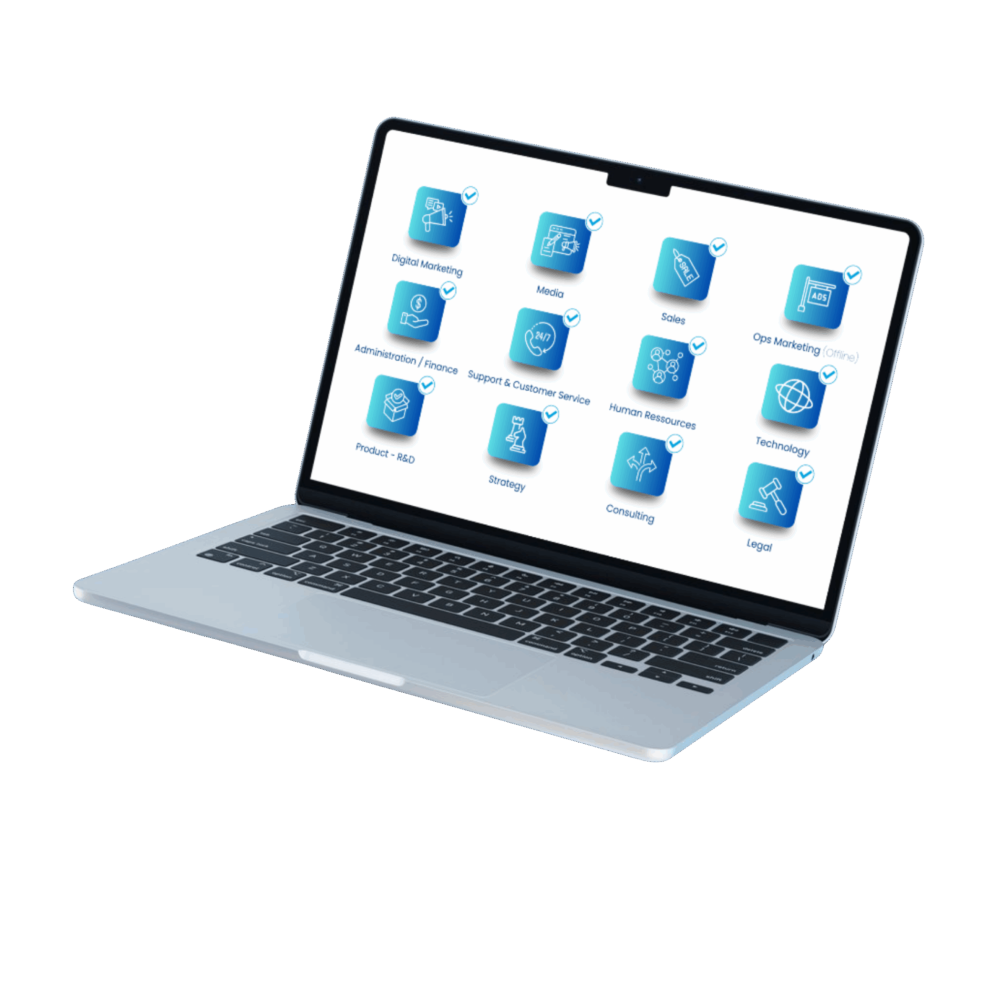AI tools for searching texts in images complete 2025 guide for B2B

How much time does your business spend searching for important information buried in images, scanned contracts, or the stack of receipts from your last quarter? Every day, businesses around the world create over 2.5 quintillion bytes of data—yet nearly 80% of this is unstructured, like images, PDFs, and photos of handwritten notes. Buried in these visuals are customer details, product specs, or financial numbers that—until recently—meant hours of manual typing and wasted effort.
Modern OCR text extraction powered by AI can boost efficiency, with error rates dropping by over 20% for enterprise teams who automate their document workflows.
Things are different now. What used to be a laborious, error-prone task has evolved, thanks to AI tools for searching texts in images. Modern OCR text extraction software built on artificial intelligence can process thousands of documents an hour, and accuracy is now routinely over 99%. Imagine converting shipping labels, legacy blueprints, or hand-filled forms into searchable knowledge—literally transforming hours of administrative headache into strategic business insights. Some global enterprises have seen document handling times fall by more than 70% and a substantial drop in data errors after adopting AI-powered visual text search. And you do not need to be a Fortune 500 company to see the benefits; SMEs and scaling businesses are embracing these tools as critical infrastructure for smart, data-driven growth.
Smart automation with AI helps SMEs as much as enterprises, cutting costs and unlocking new insights instantly.
This 2025 guide shares exactly how these technologies work, what kind of automation opportunities they enable, and real-world B2B use cases. If you are supervising operational audits, want to streamline contract processing, or are looking to digitize historical archives, understanding these tools will empower your next wave of business transformation.
Understanding AI-powered text recognition technology
OCR technology for B2B business automation has improved by leaps and bounds over the last ten years. No longer limited to scanned forms in perfect condition, today’s AI image text recognition systems can handle everything from faded blueprints to a crumpled receipt taken with a smartphone. What makes these intelligent character recognition tools so powerful? The secret is how they combine the latest advances in computer vision, machine learning, and natural language processing.
For example, when a retail business processes hundreds of multi-language order forms daily, AI-powered visual text search will not only extract customer addresses but also recognize that “Total Amount” in French, German, or Mandarin refers to the same key data point.

How OCR and AI work together
Classic OCR solutions worked by matching pixel patterns to stored character images—a method that quickly fell apart when faced with less-than-perfect scans, messy handwriting, or stylized branding. AI has changed the game using convolutional neural networks trained on huge, diverse sets of real business documents. These models now recognize text in almost any font, rotation, or lighting condition. The upshot? Accuracy that approaches or exceeds human data entry in many commercial settings.
One real-world result comes from a financial firm that saw error rates plummet by over 20% after switching to AI-driven OCR—saving thousands of employee hours annually and improving downstream analytics.
Machine learning models for text detection
What about tricky scenarios like faded handwriting on scanned forms or complex layouts in legal contracts? Here, models such as CRAFT and EAST excel at recognizing text regardless of orientation or font. Transformer models are making AI tools for searching texts in images even better at piecing together meaning, improving success rates on documents with tears, blurs, or noise. These advances depend on machine learning model training capabilities—and B2B vendors with deep sector datasets show the most versatility for edge cases.
Natural language processing integration
Extracting text is merely the first step; making sense of that text is where business value is unlocked. Modern business document digitization AI leverages NLP to categorize, route, and even interpret extracted content. Language detection, semantic entity extraction, and context-aware tagging are standard for top B2B AI-powered visual text search platforms—reducing manual handoff and speeding up enterprise processes.
Top AI tools for searching text in images in 2025
With the market now teeming with solutions, how do you choose the right AI image text recognition technology for your business? Selection matters. Compare not just headline accuracy scores, but how well each tool integrates with your CRM or ERP and how it supports compliance needs.

Google Cloud Vision API
This platform is recognized for broad language compatibility, high performance across both printed and handwritten documents, and seamless integration with Google business environments. Its model training capabilities also offer customization, though most organizations leverage robust standard models out-of-the-box.
Microsoft Azure computer vision
Azure Computer Vision combines advanced recognition for printed and handwritten content with native integration to Microsoft 365, Power Automate, and enterprise workflow tools. Mid-market companies appreciate built-in security and audit features plus strong support for multi-language documents.
Amazon Textract
This enterprise OCR automation solution stands out for structure recognition. Textract maintains the relationships between tables, forms, and data fields, vital when processing complex logistics, HR documentation, or financial statements. Deep integration across AWS and natural language Q&A about document content creates powerful workflow automation.
ABBYY FineReader Enterprise
When document accuracy, legal compliance, or layout preservation are paramount, ABBYY FineReader is a premier option for governments, regulated industry, and archival projects. Its multi-language support—covering over 200 scripts and historical typefaces—and high-fidelity layout retention help organizations safeguard both content and document meaning.
Choose a solution that fits your industry-specific needs—integration and compliance are just as critical as top-line accuracy.
Tesseract OCR with AI enhancements
Best for organizations needing flexibility or on-premises deployment, Tesseract pairs with AI-based enhancements like LSTM neural networks. Manufacturing or R&D companies can train their own models within secure environments, ensuring sensitive data never leaves internal infrastructure.
Business use cases for AI text recognition
Where does all this technology drive bottom-line results in the B2B world? Let us bring it down to earth.

Invoice and receipt processing automation
Finance teams have historically been slowed by manual entry or correction. Now, AI-driven OCR automates supplier invoice processing, extracting critical data and cross-checking it against purchase orders. Firms report approval cycle times dropping by over 75%, with built-in automated policy validation rules catching non-compliant charges before reaching finance.
Contract and legal document analysis
Legal and compliance departments, particularly in regulated industries, use AI image text recognition to scan vast contract archives for risk clauses or regulatory triggers. What used to mean weeks of page-by-page review now takes minutes.
AI transforms weeks of manual legal review into minutes, supporting strategic responses in compliance-heavy industries.
Customer support ticket resolution
Instead of agents transcribing order numbers from blurry photos, OCR technology recognizes error codes or serial numbers, speeding issue resolution and letting service teams focus on complex customer concerns.
Supply chain and logistics documentation
Managing supply chain paperwork is now automated end-to-end. Real-time label scanning in warehouses feeds directly into inventory management, reducing mis-shipments or shortages.
Marketing and social media monitoring
Marketing teams are not just analyzing hashtags—they are scanning images for logos, product shots, and pricing. AI-powered visual text search helps track competitor activity and analyze campaign effectiveness.
Integration with existing business systems
No B2B automation succeeds in a vacuum. The real value from AI tools for searching texts in images is unlocked only when your CRM, ERP, and document management platforms all work alongside your chosen OCR text extraction software, eliminating data silos and manual bridges.

CRM integration for customer data extraction
Imagine a sales team returning from a trade fair. Instead of waiting days for manual data entry, they snap photos of business cards and, through CRM data accuracy integrations, fields auto-populate into Salesforce or Dynamics.
ERP system connection for financial processing
Connecting intelligent character recognition tools with ERP platforms enables fully digital workflows for payables, procurement, and expense management, freeing finance and operations teams from repetitive tasks.
Document management system workflows
AI-powered visual text search converts millions of scanned files in SharePoint or Google Drive into a living database. Critical contract dates, compliance annotations, or medical codes are extracted as metadata and filed automatically for fast retrieval.
API integration and custom development
For complex needs, REST APIs unlock custom workflows—triggering text recognition on new documents, customizing routing, or feeding results directly to analytics tools without reinventing the wheel.
Accuracy and quality considerations
High performance AI tools for searching texts in images are only as good as the documents they process. Image quality, scan resolution, and document type all influence results. The best B2B projects combine technology selection with systematic approaches to image quality, review workflows, and continuous accuracy improvement.

Image quality and resolution requirements
Documents should be scanned at 300 DPI or higher for best results. The smartest platforms apply image quality assessment to flag suboptimal files, reducing manual error correction downstream.
Handling handwritten and stylized text
Not all B2B documents are printed—many handle handwritten time sheets, client forms, or product packaging with stylized fonts. Industry leaders train custom models to boost recognition rates where out-of-the-box tools would struggle.
Multi-language and character set support
Global businesses juggle invoices in German, contracts in Mandarin, and compliance documents in Arabic. Platforms must understand language-specific data structures and validate them correctly for seamless digitization.
Verification and quality assurance workflows
Organizations succeed with AI-powered visual text search by building in layered quality checks: high-confidence results move forward automatically; low-confidence extractions are flagged for human validation, ensuring year-on-year improvements.
Security and compliance for enterprise OCR
For sectors dealing with sensitive data—from healthcare to financial services—security, privacy, and regulatory compliance are non-negotiable.

Data privacy and GDPR compliance
Personal data extracted via AI must comply with regional laws. European companies need document processing within EU data centers and clear protocols for GDPR right to erasure requests, with customization options for retention, deletion, and consent management policies.
On-premise vs cloud security models
Cloud offers flexibility and scale, but strict requirements may demand on-site deployment. Hybrid models are gaining popularity, balancing convenience and full compliance.
Industry-specific compliance requirements
Organizations ensure technology choices match standards for data integrity, liability, and chain of custody with configuration options for audit trails, field-level redaction, and multi-factor authentication.
ROI and performance metrics
Ultimately, adopting automated text search in images must pay off in concrete performance improvements. Decision-makers justify investments by measuring the time, cost, and risk savings versus legacy manual processes.

Calculating time savings from automation
Companies discover through time studies that each manual invoice or document entry consumes seven to ten minutes. AI can reclaim entire headcounts for strategic tasks, with service providers reporting monthly savings of nearly 250 hours.
Error reduction and accuracy improvements
Manual keying introduces mistakes—incorrect codes, missed clauses—that snowball into disputes or lost revenue. AI-powered visual text search regularly delivers over 98% accuracy, reducing follow-ups and improving analytics.
Cost-benefit analysis framework
Implementation outlays are balanced against time and error savings, improved compliance, and avoided regulatory penalties. Most mature projects recover costs within 12–18 months, with growing savings long-term.
Implementation best practices
No technology can deliver results without smart implementation. Leading B2B projects start with tightly-scoped pilots—often invoice processing or compliance workflows—where baseline metrics are tracked before and after.

Starting with pilot projects
Tightly focused pilots and defined success criteria provide proof for leadership and user buy-in. Tracking invoice approval times and error rates over 90 days lays the groundwork for scaling.
Training and change management
Leading companies supplement technical onboarding with hands-on workshops. Employee understanding of the “why” boosts adoption and speeds transition from manual to automated work.
Scaling across departments
Once pilots demonstrate success, expansion targets high-impact adjacent processes. Standardization keeps knowledge transferable as new business units onboard automated text search in images.
Continuous optimization and monitoring
The best B2B organizations treat implementation as iterative: dashboard monitoring, internal user feedback, technology reviews, and retraining cycles deliver year-on-year gains in accuracy and efficiency.
Future trends in AI text recognition
What is coming next? AI tools for searching texts in images are evolving, and the future is shaped by real-world B2B demands.

Real-time video text recognition
Scanning shipping labels or safety signage from live video feeds in logistics centers is unlocking instant, actionable insights for field teams, remote support, and retail audits. These technologies will power compliance tracking and pricing tactics.
Augmented reality and mobile applications
Field service and logistics teams use AR-enabled devices for maintenance, inspections, and product demos—turning every process into a data capture opportunity. Mobile AI recognition brings new contextual overlays and real-time automation.
Edge computing for privacy-first processing
Organizations want security and speed—processing information close to the source, not cloud servers. On-site devices with neural chips enable compliance in regulated industries by keeping sensitive documents local.
Multimodal AI understanding
Next-generation digitization AI will interpret documents combining text, context, and visual cues—enabling proactive business decisions and smarter compliance in every sector.
Adopt AI-powered tools today to future-proof your business and stay at the forefront of digital transformation.
AI tools for searching texts in images are no longer niche—they’re shaping the way businesses manage, process, and protect critical information. As AI-powered visual text search becomes embedded into business systems, you gain not only speed and accuracy but deeper compliance, better data quality, and a surge in operational agility. Looking ahead, real-time recognition and human-level multimodal intelligence will transform how businesses leverage and protect their information assets worldwide.
Ready to unlock AI-driven text extraction?
Discover our smart AI solutions for business automation today and get ahead with fast, secure document workflows.
FAQ
What is the difference between OCR and AI-powered text recognition?
Traditional OCR is mostly based on template and pattern matching, making it work best for clean, uniform documents. AI-powered text recognition, on the other hand, relies on deep learning models like convolutional neural networks that learn from a diverse set of documents. This allows them to handle variations in font, orientation, and even noise, while learning and improving accuracy over time—often exceeding 98% on challenging B2B files. AI-based tools are also better at making sense of context and correcting errors automatically.
Can AI text extraction handle handwritten documents?
Yes, but results depend on the quality of handwriting and the language. Print handwriting can see 90–95% accuracy, while cursive might yield 70–85%. B2B firms improve recognition over time by training AI models on their own data through feedback loops and pilot trials.
How secure is cloud-based OCR for sensitive business documents?
Enterprise-grade OCR software secures data in transit and at rest and comes with certifications like SOC 2 Type II and GDPR compliance. Vendors offer customer-controlled encryption keys and data residency, but firms with stricter needs may choose private deployments.
What accuracy rate should I expect from modern AI text recognition?
Accuracy depends on document quality, but enterprise-grade OCR solutions often reach 97–99% on high-quality scans, and 92–96% for most business photos or receipts. For handwritten or stylized content, pilots set the most realistic expectations.
How long does it take to implement AI text extraction in a business?
A cloud-based trial can be operational in 4–6 weeks for a simple workflow. Larger rollouts may span several months. Focused department pilots develop value quickly, but broader change should involve both IT and process owners.
Can AI OCR tools process documents in multiple languages?
Yes, most modern platforms process 50–200+ languages, detecting and switching models automatically. For international documents, always verify real-world performance with your target languages.
Share this article
Share this article on your social networks


